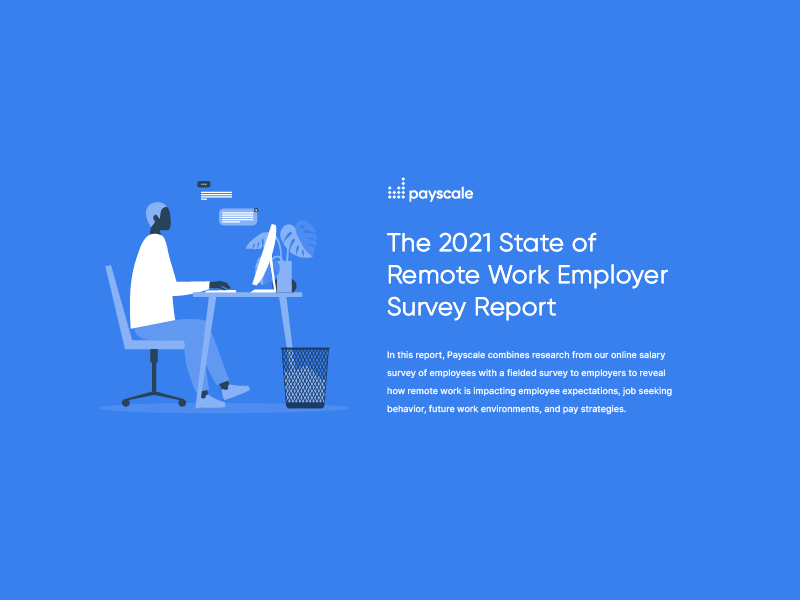The 2021 State of Remote Work Report
Payscale’s research reveals that 43 percent of employees expect more organizations to offer remote work after the pandemic comes to an end. Payscale’s research also shows that fully remote workers earn more than non-remote workers, even when controlling for job characteristics, and that remote workers reported higher rates of job satisfaction and retention than non-remote workers. A survey of employers shows how organizations are shifting their remote work strategies.

Summary: Remote work is beneficial to businesses
Remote work is set to expand substantially following the end of the pandemic compared to pre-pandemic levels. And there’s a good reason why. During the pandemic, organizations have largely experienced increased productivity from a workforce that has been primarily working from home, and employees have primarily found that they like it.
Using data from 538,438 online salary profiles collected from July 2019 to July 2021, Payscale analyzed how expectations around remote work has changed, and particularly for which occupations, as not all jobs can be performed remotely. In addition, we analyzed how employees who work remotely are paid compared to non-remote workers as well as whether employees working remotely are more satisfied with their jobs and exhibit lower rates of seeking a new job.
Overall, the report shows that 43 percent of employees expect more employers to offer remote work after the pandemic has ended, with certain occupational groups reaching as high as 75 percent. Our analysis also finds that remote workers have higher rates of reporting job satisfaction and lower rates of reporting job seeking behavior. Remote workers earn higher pay on average compared to non-remote workers.
To get the employer perspective, we also fielded a survey with organizations, asking HR leaders what percentage of their employees will work remotely after the pandemic compared to before the pandemic. We also inquire how their office environment will be evolving to accommodate remote work as well as their pay strategy for remote workers. To access full responses from the survey, download the complete report from our 2021 State of Remote Work Employer Survey.
Download the full reportEmployees have high expectations for remote work
Overall, a significant portion of employees (43 percent) expect more organizations to offer remote work after the pandemic comes to an end. For occupational groups like Marketing & Advertising and Information Technology, this increases to 75 percent and 71 percent of employees respectively.

Employees who can work remotely are more satisfied with their jobs
Payscale’s analysis shows that employees who can’t work from home are frequently less satisfied and more often hate their job than people who telecommute all of the time, most of the time, some of the time, or on an as needed basis. The percentage of non-remote employees grows with each dissatisfaction level.
Percentage of Non-remote Workers Grows with each Dissatisfaction Level

Not everyone who can’t telecommute is dissatisfied with their job, of course. A majority of employees (64 percent) who can’t telecommute are either extremely or fairly satisfied with their job. In addition, employees who telecommute 100 percent of the time are somewhat less satisfied with their jobs than people who telecommute most of the time. This implies that employees are happiest when they can choose when to go into an office as needed but can work from home when it’s more productive.
Job Satisfaction by Remote Work Status

Earnings Difference by Remote Status

Employees who work remotely don't earn less compensation
Overall, Payscale found that employees who telecommute 100 percent of the time (fully remote) earn more compensation than employees who do not work remotely at all. This correlates to the difference in salaries between white-collar and blue-collar workers. Holistically, when data are not controlled for job titles and other compensable factors, employees who work remotely make 23.7 percent more than non-remote employees. When we control for compensable factors like job title and location, employees who work remotely make 1.9 percent more than non- remote employees.
However, employees who answered that they can telecommute most of the time, some of the time, or on an as-needed basis earned more than both fully remote workers and non-remote workers. This implies that the highest paying opportunities are in hybrid work environments or where employees are more trusted and have autonomy to choose where they work. The large pay differences between partial and fully remote workers when data are uncontrolled may also be explained by job level. Managers and above who earn higher salaries might face expectations to go into the office at least some of the time compared to individual contributors better positioned to work remotely full time.
Part-time Remote Workers Earn More Compared to Fully Remote Workers
 Download the full report
Download the full report
Differences in the percentage of remote workers and how much they earn vary by industry
Payscale analyzed the impact of remote work by industry. The analysis measures the differences in earnings between employees who work fully remote and employees who do not work remotely, both holistically and controlling for specific job title. Payscale also looked at job satisfaction and intent to leave between remote workers and non-remote workers by industry.
Overall, Payscale found that employees who work remote earn more than employees who do not work remote in all industries except for blue collar occupations such as construction and transportation and warehousing, as well as healthcare were most jobs have to be performed on site.
Industries where employees make the most working remotely include the nonprofit sector and information technology when data are controlled for job titles and other compensable factors.
Difference in Earnings of Fully Remote Workers, by Industry

Differences in the percentage of remote workers and how much they earn vary by occupation
PayScale analyzed the impact of remote work by occupational group. The analysis measures the differences in earnings between employees who work fully remote and employees who do not work remotely, both holistically and controlling for specific job title. Payscale also looked at job satisfaction and intent to leave between remote workers and non-remote workers by occupational group.
Overall, Payscale found that employees who work remote earn more than employees who do not work remote in all occupations that do not have a propensity for needing to be onsite, including blue collar occupations such as transportation, construction, manufacturing and production, and installation, maintenance, and repair when data are controlled for job title and other compensable factors, as well as food services, healthcare, and retail when data are uncontrolled.
Some occupations, such as marketing and advertising, make significantly more when working remote, even when data are controlled for job titles and other compensable factors, which also aligns to expectations these occupations have for remote work opportunities to increase.
Difference in Earnings of Fully Remote Workers, by Occupation

% of Total Job Seekers by Remote Status

Employees who can't work remotely comprise a greater share of job seekers
Job seeking behavior is most predominant among workers who can’t telecommute (55 percent). Job seeking behavior is lowest among employees who say they telecommute most of the time. Similar to job satisfaction, employees who work remotely most of the time likely have the most autonomy over their work environment.
Survey response highlights
What employers are saying about their remote work strategy
Job seeking behavior is most predominant among workers who can’t telecommute (55 percent). Job seeking behavior is lowest among employees who say they telecommute most of the time. Similar to job satisfaction, employees who work remotely most of the time likely have the most autonomy over their work environment.

Which of the Following Best Describes Your Organization’s Workplace Before and After the Pandemic?
 Download the Employers Survey report
Download the Employers Survey report
Get pay right for remote workers with Payscale
Organizations looking to evolve how they manage compensation to encompass remote workers should invest more in compensation strategy and software.
Read our whitepaper on Remote Work Pay StrategiesLooking for help determining the right pay structure to accommodate a growing remote workforce? Download our whitepaper on Formulating a Remote Work Pay Strategy.
Download the whitepaper Explore location-based pay solutions with Payscale’s Differentials EngineLearn how Payscale’s AI-powered differentials engine and Crowdsourced data can help you determine and apply pay premiums for specific jobs and skills in specific geographical markets.
Learn more Get a full demo of Payscale’s Compensation SoftwareReady to up your compensation game right now? Request a demo to learn about Payscale’s compensation software, data, and services to help you get pay right.
Request a demo
Methodology
Payscale provides an analysis of median pay for remote and non-remote workers nationally and by industry and occupation, using a controlled and uncontrolled analysis to account for pay differences between these groups. We also provide response rates to the below research questions:
Job satisfaction: "How satisfied are you in your job?"
- Extremely satisfied
- Fairly satisfied
- A little satisfied
- Dissatisfied
- I hate my job
In the next 6 months, I plan on actively seeking new jobs outside my current company
- Yes
- No
Following work from home ordinances in 2020, have your expectations for remote work in your occupational field changed?
- No, my expectations have not changed.
- Yes, I expect more employers to offer remote work options in my field.
- Yes, I expect fewer employers to offer remote work options in my field.
Definitions
Total Cash Compensation (TCC): TCC combines base annual salary or hourly wage, bonuses, profit sharing, tips, commissions, and other forms of cash earnings, as applicable. It does not include equity (stock) compensation, cash value of retirement benefits, or value of other non-cash benefits (e.g., healthcare).
Median Pay: The median pay is the national median (50th percentile) annual total cash compensation. Half the people doing the job earn more than the median, while half earn less.
Uncontrolled Median Pay: Median pay for remote and non-remote workers are examined separately. The uncontrolled median pay does not control for variables such as years of experience, education or other compensable factors. This provides a picture of the differences in wages earned by remote and non-remote workers in an absolute sense.
Controlled % Difference: This is the amount that a non-remote worker earns for every dollar that a comparable remote worker earns. That is, this is the pay difference that exists between remote and non-remote workers after we control for all measured compensable factors.
Controlled Median Pay: To illustrate the pay difference between remote and non-remote workers, we calculate this estimate of what the typical non- remote worker would earn they occupied the same position as the typical remote worker.
Download our report
Get the complete report from our 2021 state of remote work employer survey
Our research shows that perception of being paid below market increases intent to leave, even when employees are actually paid at or above market. Organizations can take steps to measure these risk factors and also mitigate them with pay communications and increased pay transparency. Our full report also provides additional data on how organizations are experiencing turnover and what strategies they are using to retain employees.

By clicking Download Report, you agree to our Terms of Use and Privacy Policy.